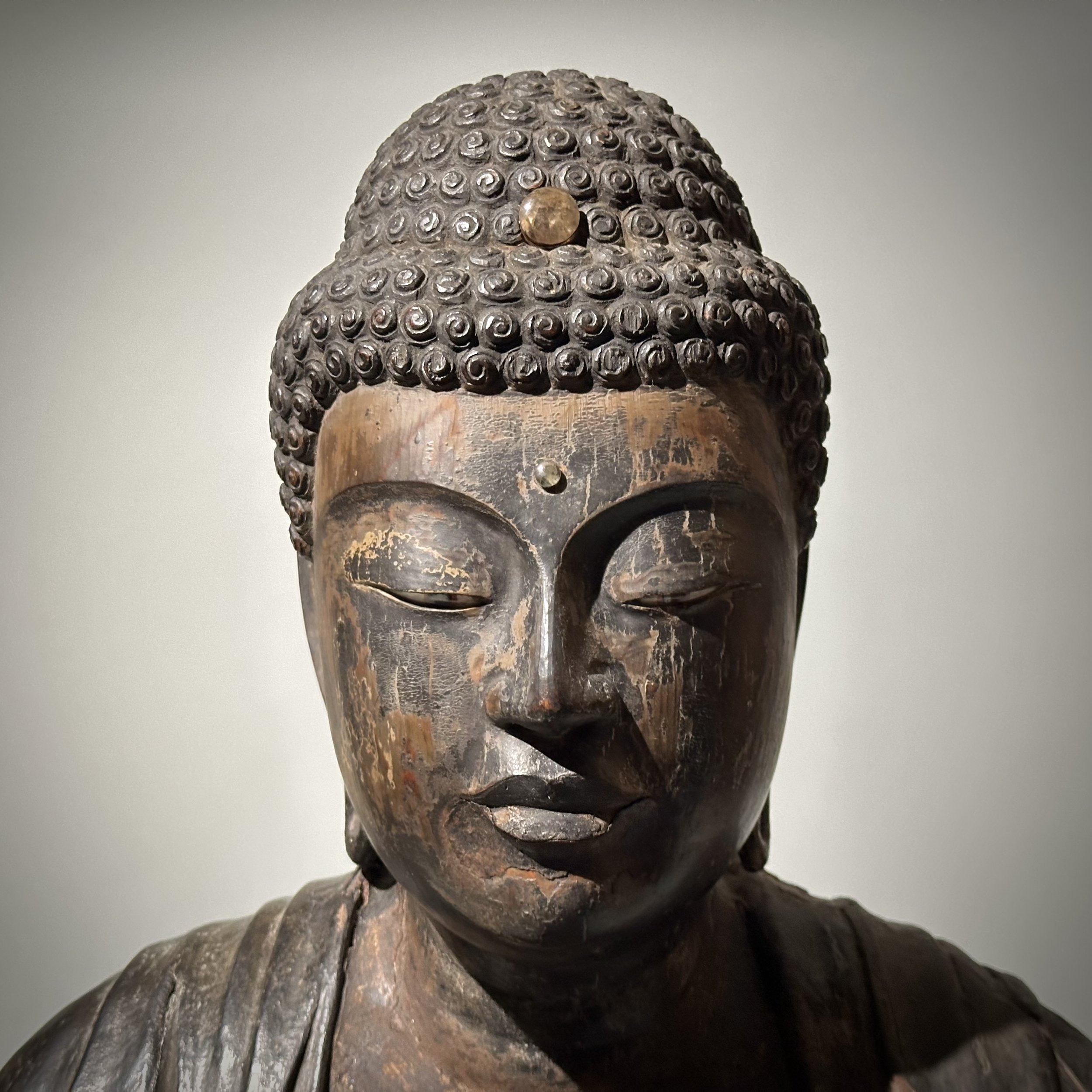Sculpture of Amida Nyorai
Japan
Muromachi Period (1336-1573), c. 15th century or earlier
The large figure of Amida Nyorai (Amitabha Buddha) is seated in dhyanasana, carved from joined cypress or similar softwood in yosegi-zukuri technique, with a serene expression cast over an unusually naturalistically modelled face, the eyes inlaid with reverse-painted rock-crystal, further rock-crystal inset into the forehead and amongst the rahotsu hair representing the byakugo and nikkei-shu, the hands raised in a rare double vitarkamudra, the surface with a beautiful aged patina with remnant lacquer and gilding in parts. Original inscription to the base (unread) in black ink. Old wear, losses and restorations/repairs. 63cm high, 50cm wide, 36cm deep.
This sculpture is notable in that it displays two features rarely encountered in figures of Amida Nyorai. The first is the very unusual style in which the face is modelled, with fleshier lips as seen on some rare Heian and Kamakura figures, and a longer and more naturalistic face than would usually be seen. One comparably elongated face also with fleshier lips can be found on a remnant head from a once very large Amida sculpture in the British Museum tentatively dated to 14th-15th century (registration number 1950,1025.1). The other interesting feature is the hands held up in double vitarkamudra mirroring each other, which is one of the rarer seen mudras in Amida sculptures, used to represent welcoming of dead devotees into the upper middle birth level (chubon-josho) of the nine levels of rebirth in The Pure Land (Jodo).
Japan
Muromachi Period (1336-1573), c. 15th century or earlier
The large figure of Amida Nyorai (Amitabha Buddha) is seated in dhyanasana, carved from joined cypress or similar softwood in yosegi-zukuri technique, with a serene expression cast over an unusually naturalistically modelled face, the eyes inlaid with reverse-painted rock-crystal, further rock-crystal inset into the forehead and amongst the rahotsu hair representing the byakugo and nikkei-shu, the hands raised in a rare double vitarkamudra, the surface with a beautiful aged patina with remnant lacquer and gilding in parts. Original inscription to the base (unread) in black ink. Old wear, losses and restorations/repairs. 63cm high, 50cm wide, 36cm deep.
This sculpture is notable in that it displays two features rarely encountered in figures of Amida Nyorai. The first is the very unusual style in which the face is modelled, with fleshier lips as seen on some rare Heian and Kamakura figures, and a longer and more naturalistic face than would usually be seen. One comparably elongated face also with fleshier lips can be found on a remnant head from a once very large Amida sculpture in the British Museum tentatively dated to 14th-15th century (registration number 1950,1025.1). The other interesting feature is the hands held up in double vitarkamudra mirroring each other, which is one of the rarer seen mudras in Amida sculptures, used to represent welcoming of dead devotees into the upper middle birth level (chubon-josho) of the nine levels of rebirth in The Pure Land (Jodo).
Japan
Muromachi Period (1336-1573), c. 15th century or earlier
The large figure of Amida Nyorai (Amitabha Buddha) is seated in dhyanasana, carved from joined cypress or similar softwood in yosegi-zukuri technique, with a serene expression cast over an unusually naturalistically modelled face, the eyes inlaid with reverse-painted rock-crystal, further rock-crystal inset into the forehead and amongst the rahotsu hair representing the byakugo and nikkei-shu, the hands raised in a rare double vitarkamudra, the surface with a beautiful aged patina with remnant lacquer and gilding in parts. Original inscription to the base (unread) in black ink. Old wear, losses and restorations/repairs. 63cm high, 50cm wide, 36cm deep.
This sculpture is notable in that it displays two features rarely encountered in figures of Amida Nyorai. The first is the very unusual style in which the face is modelled, with fleshier lips as seen on some rare Heian and Kamakura figures, and a longer and more naturalistic face than would usually be seen. One comparably elongated face also with fleshier lips can be found on a remnant head from a once very large Amida sculpture in the British Museum tentatively dated to 14th-15th century (registration number 1950,1025.1). The other interesting feature is the hands held up in double vitarkamudra mirroring each other, which is one of the rarer seen mudras in Amida sculptures, used to represent welcoming of dead devotees into the upper middle birth level (chubon-josho) of the nine levels of rebirth in The Pure Land (Jodo).










